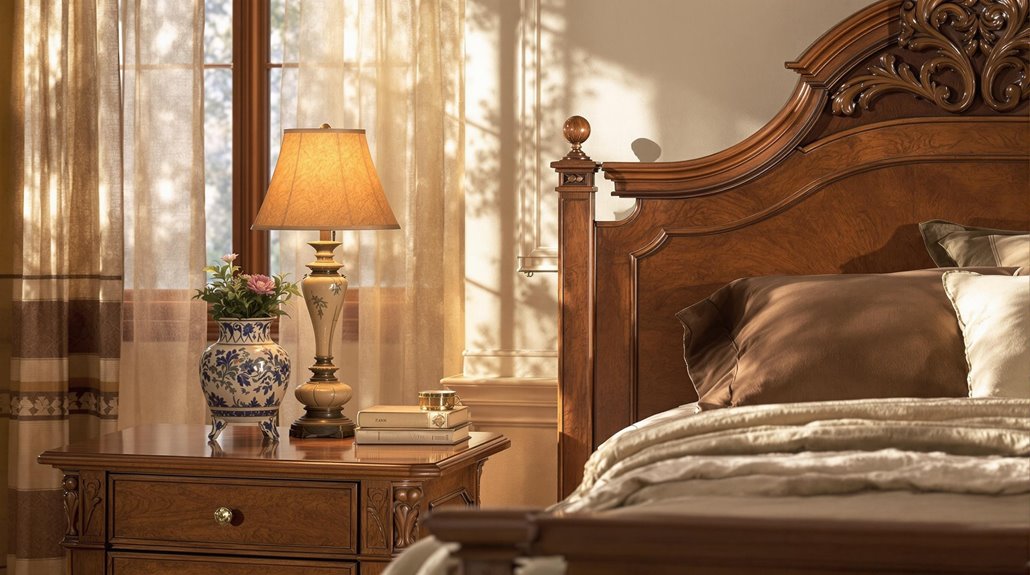Solid wood bedroom furniture is worth it due to its unmatched durability, aesthetic appeal, and long-term value. Crafted from hardwoods such as oak or maple, these pieces can last over 50 years with proper care, considerably outlasting composite alternatives. The investment potential is also notable, as high-quality items can appreciate in value and may be passed down through generations. Additionally, solid wood furniture enhances indoor air quality and aligns with sustainability goals. While initial costs may be higher, the savings in maintenance and replacement make it a prudent choice. Further insights into its advantages are available.
Durability and Longevity
When considering bedroom furniture, durability and longevity are paramount factors that greatly influence the overall value of solid wood pieces. Solid wood furniture, particularly made from hardwoods like oak, maple, and walnut, offers superior resistance to dents and scratches, considerably extending its lifespan. Properly crafted solid wood items can endure for 50 years or more, especially when made from high-quality materials that resist warping and cracking due to environmental changes. Furniture with advanced joinery techniques, such as dovetail or mortise-and-tenon joints, further enhances structural integrity. Regular maintenance, including cleaning and protection from extreme conditions, is essential for sustaining its durability. In contrast, composite materials typically lack the longevity associated with solid wood, reinforcing its value as a lasting investment.
Value as an Investment
When considering solid wood bedroom furniture as an investment, it is essential to recognize its long-term value retention and heirloom potential. Unlike pieces made from synthetic materials, high-quality solid wood furniture is more likely to maintain its worth over time, often becoming more valuable due to its craftsmanship and durability. In addition, such furniture can be passed down through generations, enhancing its appeal as a lasting asset in a household.
Long-term Value Retention
While many furniture options may promise affordability, solid wood bedroom furniture stands out as a wise investment due to its impressive long-term value retention. The durability and longevity of solid wood pieces mean they can last for decades, reducing the frequency of replacements and ultimately leading to significant cost savings. Additionally, solid wood furniture requires minimal maintenance, with regular cleaning and occasional refinishing sufficient to preserve its condition. Its natural beauty and timeless design contribute to a high resale value, often recouping a substantial portion of the initial investment. Unlike cheaper materials, solid wood does not depreciate quickly, making it a practical choice for those seeking enduring quality and financial prudence in their furniture selections.
Heirloom Potential
Solid wood bedroom furniture embodies heirloom potential, serving as a tangible investment that can be passed down through generations. The durability and longevity of solid wood, crafted from single pieces of timber, guarantee that these pieces withstand the test of time with proper care. Unlike engineered wood or particleboard, solid wood is less prone to wear and tear, reducing the need for repairs. Additionally, its ability to be customized regarding wood type and finish allows for personalization, accommodating evolving tastes and styles. With its timeless aesthetic appeal and superior craftsmanship, solid wood furniture not only retains its value but may also appreciate over time, making it an attractive investment for the future.
Aesthetic Appeal and Versatility
The aesthetic appeal and versatility of solid wood bedroom furniture make it a timeless choice for any home. Unique grains and natural textures add warmth and sophistication, guaranteeing that no two pieces are identical. Available in various hues, from light to rich dark tones, solid wood enhances the bedroom's ambiance while capturing the essence of both traditional and modern design movements. This furniture seamlessly integrates into diverse settings, including rustic farmhouse and contemporary minimalist styles. Customization options allow for tailored sizes, shapes, and finishes, enabling homeowners to express personal style effectively. Additionally, the enduring beauty of solid wood guarantees that it remains a striking statement piece, appealing across a range of design preferences without losing relevance over time. Moreover, the bulk purchasing opportunities provided by wholesale suppliers make it easier for retailers to offer a variety of solid wood options to consumers.
Maintenance and Care Tips
How can you guarantee the longevity and beauty of your solid wood bedroom furniture? Regular maintenance is essential. Begin by dusting surfaces with a soft cloth or microfiber duster to prevent scratches. For deeper cleaning, utilize a damp cloth with mild soap or a vinegar-water solution, always wiping along the wood grain. Protect surfaces with coasters and mats, avoiding direct contact with rubber or plastic that can harm finishes. Maintain ideal humidity levels between 40 to 45 percent, and keep furniture away from direct sunlight and temperature extremes. Handle pieces carefully to avoid damage, check hardware periodically, and promptly address spills with a dry cloth. This proactive approach guarantees your furniture retains its charm and structural integrity over time.
Quality and Craftsmanship Standards
While many factors contribute to the overall value of bedroom furniture, quality and craftsmanship stand out as essential elements that define solid wood pieces. Solid wood furniture, crafted from high-quality materials like oak, walnut, maple, and cherry, exhibits notable strength and longevity. Unique grain textures enhance the aesthetic appeal, while solid wood's resistance to wear surpasses that of alternatives like particle board. Superior construction techniques, such as Mortise & Tenon joinery and precise milling, guarantee robust and stable furniture. Additionally, high-quality finishes and solid metal hardware enhance durability and overall quality. Opting for reputable brands, often accompanied by lifetime warranties, further assures adherence to stringent craftsmanship standards, making solid wood furniture a worthwhile investment.
Budget Considerations
What factors should be considered when budgeting for solid wood bedroom furniture? First, the cost variability based on wood type is significant; high-quality hardwoods like oak and cherry often command higher prices compared to more affordable options like Red Oak and Maple. Prices for solid wood bed frames can range from $300 to $3,000, influenced by size and craftsmanship. Additionally, consider the durability of solid wood, which can lead to long-term savings by reducing replacement and repair costs. Establishing a clear financial plan is essential, ensuring that the budget accommodates all necessary pieces and follows a logical allocation strategy, such as designating 30%-40% for the bed frame. This structured approach enables informed decisions without compromising quality.
Alternatives to Solid Wood
When considering alternatives to solid wood bedroom furniture, engineered wood options such as plywood and MDF emerge as practical choices, offering durability and affordability. Additionally, metal furniture alternatives provide a modern aesthetic while ensuring longevity, making them suitable for those seeking a stylish yet resilient option. Together, these alternatives cater to various design preferences and budget constraints, highlighting the versatility of non-solid wood materials in contemporary bedroom settings.
Engineered Wood Options
Engineered wood options present a compelling alternative to solid wood for those seeking affordability and versatility in furniture design. Generally more cost-effective, engineered wood products, such as MDF and plywood, can save consumers significant sums—up to $435 less for a TV console compared to its solid wood counterpart. Additionally, engineered wood is environmentally friendly, utilizing recycled wood particles and reducing waste. Its production is less energy-intensive, promoting sustainability. While engineered wood is less durable regarding lifespan, it offers advantages such as water resistance, termite resistance, and reduced warping. Moreover, its lightweight nature facilitates easy installation and movement, making it suitable for various applications, including furniture, flooring, and paneling, particularly in high-traffic areas.
Metal Furniture Alternatives
While solid wood furniture has long been celebrated for its timeless appeal, metal furniture alternatives offer a modern and practical solution for those seeking durability and design versatility. Metal furniture is highly durable, capable of withstanding heavy use while resisting stains and scratches, making it ideal for high-traffic areas. Unlike wood, it requires minimal maintenance, as it does not need frequent polishing or refinishing. Aesthetic options abound, with finishes ranging from polished chrome to powder-coated colors, allowing for creative designs that can blend with various styles. Additionally, metal furniture is sustainable, often recyclable, and its longevity contributes to a reduced environmental footprint. This combination of practicality and style makes metal furniture an attractive alternative to solid wood.
Long-Term Benefits
Investing in solid wood bedroom furniture offers significant long-term benefits that extend beyond mere aesthetics. Its durability and longevity stem from being crafted from a single piece of timber, ensuring strength and resistance to wear. Unlike cheaper materials, solid wood does not chip or buckle, making it ideal for larger bed frames. Additionally, its design versatility allows it to complement various styles, adapting to changing trends over time. Environmentally, solid wood furniture is less likely to end up in landfills and can be recycled, while also promoting better indoor air quality by reducing allergens. Financially, high-quality hardwoods can appreciate in value, providing lasting value for money and the potential to become treasured heirlooms.

